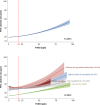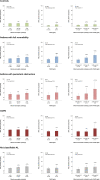Type-2 inflammation and lung function decline in chronic airway disease in the general population
- PMID: 38195642
- PMCID: PMC10958305
- DOI: 10.1136/thorax-2023-220972
Type-2 inflammation and lung function decline in chronic airway disease in the general population
Abstract
Background: It is unclear if type-2 inflammation is associated with accelerated lung function decline in individuals with asthma and chronic obstructive pulmonary disease (COPD). We tested the hypothesis that type-2 inflammation indicated by elevated blood eosinophils (BE) and fraction of exhaled nitric oxide (FeNO) is associated with accelerated lung function decline in the general population.
Methods: We included adults from the Copenhagen General Population Study with measurements of BE (N=15 605) and FeNO (N=2583) from a follow-up examination and assessed forced expiratory volume in 1 s (FEV1) decline in the preceding 10 years. Based on pre- and post-bronchodilator lung function, smoking history and asthma at follow-up examination, participants were assigned as not having airway disease, asthma with full reversibility (AR), asthma with persistent obstruction (APO), COPD, and not classifiable airflow limitation (NAL).
Results: FEV1 decline in mL/year increased with 1.0 (95% CI 0.6 to 1.4, p<0.0001) per 100 cells/µL higher BE and with 3.2 (95% CI 2.0 to 4.5, p<0.0001) per 10 ppb higher FeNO. Adjusted FEV1 decline in mL/year was 18 (95% CI 17 to 20) in those with BE<300 cells/µL and FeNO<20 ppb, 22 (19-25) in BE≥300 cells/µL or FeNO≥20 ppb, and 27 (21-33) in those with BE≥300 cells/µL and FeNO≥20 ppb (p for trend<0.0001). Corresponding FEV1 declines were 24 (19-29), 33 (25-40) and 44 (31-56) in AR (0.002), 26 (14-37), 36 (12-60) and 56 (24-89) in APO (0.07), 32 (27-36), 31 (24-38) and 44 (24-65) in COPD (0.46), and 27 (21-33), 35 (26-45), and 37 (25-49) in NAL (0.10), respectively.
Conclusions: Type-2 inflammation indicated by elevated BE and FeNO is associated with accelerated FEV1 decline in individuals with chronic airway disease in the general population, and this association was most pronounced in an asthma-like phenotype.
Keywords: Asthma Epidemiology; Asthma Mechanisms; COPD Pathology; COPD epidemiology; Clinical Epidemiology.
© Author(s) (or their employer(s)) 2024. Re-use permitted under CC BY-NC. No commercial re-use. See rights and permissions. Published by BMJ.
Conflict of interest statement
Competing interests: YÇ reports grants from Sanofi and personal fees from AstraZeneca, Boehringer Ingelheim, GlaxoSmithKline and Sanofi outside the submitted work. JV reports personal fees from ALK, AstraZeneca, Boehringer-Ingelheim, Chiesi, GlaxoSmithKline and Teva outside the submitted work. PL reports grants and personal fees from AstraZeneca and Sanofi and personal fees from AstraZeneca, Boehringer Ingelheim, GlaxoSmithKline, and Sanofi outside the submitted work. SA, JLM and BGN have nothing to disclose.
Figures





References
Publication types
MeSH terms
Substances
Supplementary concepts
LinkOut - more resources
Full Text Sources
Medical
Research Materials
